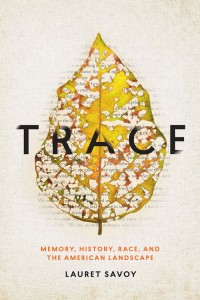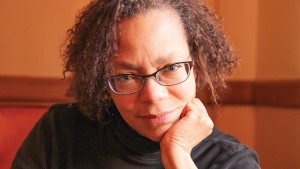Tracing the Paths of Ancestors in the American Landscape
by Judy Helfand
 On the first night of the 2015 Geography of Hope conference, I met Lauret Savoy while standing in the food line. She was an engaging conversationalist and I was almost sorry as we reached the serving tables. When I learned she was a presenter, I awaited her session eagerly and was not disappointed. At the end of the conference I picked up her edited collection of nature writings by people of color and savored the essays. This year a friend sent a blurb about a book she thought might interest me—Trace: Memory, History, Race, and the American Landscape by Lauret Savoy. I immediately ordered it from Reader’s Books, in hardback even, though my policy is usually to wait a year for the paperback edition.
On the first night of the 2015 Geography of Hope conference, I met Lauret Savoy while standing in the food line. She was an engaging conversationalist and I was almost sorry as we reached the serving tables. When I learned she was a presenter, I awaited her session eagerly and was not disappointed. At the end of the conference I picked up her edited collection of nature writings by people of color and savored the essays. This year a friend sent a blurb about a book she thought might interest me—Trace: Memory, History, Race, and the American Landscape by Lauret Savoy. I immediately ordered it from Reader’s Books, in hardback even, though my policy is usually to wait a year for the paperback edition.
Savoy is a professor of environmental studies and geology. In Traces, history becomes a geology of memory and events. In the American landscape, what is evident on the surface of a given landscape gives only hints to what lies beneath, strata of its geologic history. And the surface itself was thrust up or worn down by ice ages, merging of tectonic plates, retreat of ancient seas, forces we seldom think of. So it is with American history and our own family genealogies.
A dear friend once asked me if history is more about forgetting and deletion than about remembering and completion. The past I’ve emerged from is also broken and pitted by gaps left by silences stretched across generations. By losses of language and voice. By human displacement. By immeasurable dimensions of lives compressed and deflated. . . .
To inhabit this country is to be marked by residues of still unfolding history, a history marked by tangled ideas of “race” and of the land itself. (Traces, 185)
As a woman of mixed ancestry—free and enslaved Africans, European colonists, and people indigenous to this land—Savoy travels within the U.S. searching for traces of her family as she teases out strands of history in each place visited. History as taught, a sequential, fixed narrative, neglects what is forgotten, ignores who is speaking, focuses on the “master’s narrative.” For example, both in the South and in New England, she finds colonial graveyards polished and remembered for the European colonists buried there. The large graveyards of enslaved Africans are neglected and lost under vines and bushes, what gravestones there were, toppled and broken. As is largely the history of slavery itself, especially in the Puritan towns of New England. “How a society remembers can’t be separated from how it wants to be remembered or from what it wishes it was—that is, if we believe stories of ancestors reflect who we are and how we came to be. The past is remembered and told by desire.” (108)
Savoy explores childhood memories through their locales—north rim of the Grand Canyon, Lake Superior. She travels to the southwest borderlands of Arizona, with its complex history of indigenous peoples, Spanish, Mexican, and U.S. conquest, constant migration, and her mother’s assignment there during WWII as a black nurse in the segregated medical facilities of Fort Huachuca. Then Washington D.C. , where her father’s people lived for generations. The Piedmont. New England. Geology of the areas braids together with the human history, and she points out how the soils, the rivers, the terrain shaped human interactions in the areas. Through all of this she finds traces of her own history, the forces that shaped her ancestors and finally herself.
Beginning the book, Savoy wonders why she has felt alien, why she doesn’t have satisfying stories of her own ancestors to explain how she arrived where she is. Further, she asks how some can speak of a “post-racial” society. “Without backing belief or means, ‘rights’ become limited and limiting to legal form and process rather than a moral imperative extending from heart and spirit.” (41) As she finds the traces she seeks, the unearthed histories clearly demonstrate how we all need to tease apart the stories we tell of who we are and how we got here, looking for what’s been left out, whose voices are missing, what painful past is covered by a more palatable explanation. Savoy closes with this: “Home indeed lies within the ruins and shards that surround us all.” (186)
Trace: Memory, History, Race, and the American Landscape, Lauret Savoy. (Counterpoint Press, November 2015) Trace has its own website where you can explore the topics written about it the book and find interesting photos.
The Colors of Nature: Culture, Identity, and the Natural World, Alison H. Deming and Lauret E. Savoy, Eds. (Milkweed Editions, expanded and revised in 2011) http://www.lauretsavoy.com/books/the-colors-of-nature/


Leave a Reply